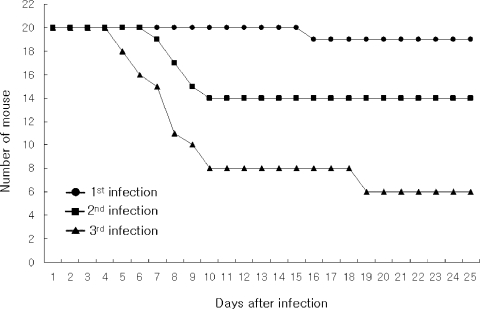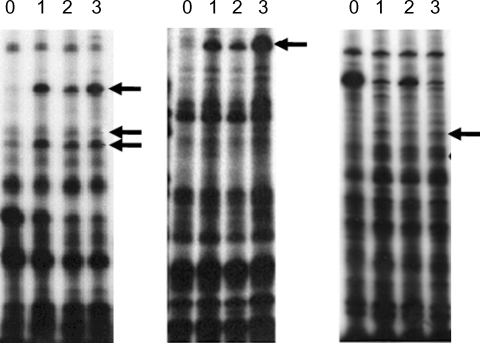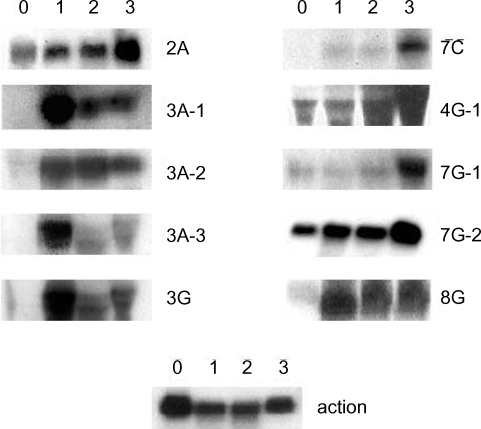1. Aaron C. The ubiquitin-proteasome proteolytic pathway. Cell. 1994. 79:13-21.


2. Abrahamsen MS, Johnson RR, Hathway M, White MW. Identification of
Eimeria bovis merozoite cDNAs using differential mRNA display. Mol Biochem Parasitol. 1995. 71:183-191.


3. Arentsen JJ, Laibson PR. Diagnosis and management of
Acanthamoeba keratitis. Am J Ophthalmol. 1985. 100:389-395.


4. Attila G, Thomas L. Disruption of mannose activation in
Leishmania mexicana GDP-mannose pyrophosphorylase is required for virulence, but not for viability. EMBO J. 2001. 20:3657-3666.



5. Chen B, Campos EI, Crawford R, Martinka M, Li G. Analysis of the tumour suppressor ING1 expression and gene mutation in human basal cell carcinoma. Int J Oncol. 2003. 22:927-931.

6. Cohen EJ, Parlato CJ, Arentsen JJ, Genvert GI, Eagle RC Jr, Wieland MR, Laibson PR. Medical and surgical treatment of Acanthamoeba. J Protozool. 1987. 32:604-607.
7. Darwin KH, Ehrt S, Gutierrez-Ramos JC, Weich N, Nathan CF. The proteasome of
Mycobacterium tuberculosis is required for resistance to nitric oxide. Science. 2003. 302:1963-1966.

8. DeMartino GN, Moomaro CR, Zagnitko OP, Proske RJ, Chu-Ping M, Afendis SJ, Swatfield JC, Slaughter CA. PA700, an ATP-dependent activator of the 20S proteasome, and ATPase is containing multiple members of nucleotide-binding protein family. J Biol Chem. 1994. 269:20878-20884.
9. Gardner HAR, Martnez AJ, Visvesvara GS, Sotrel A. Granulomatous amoebic encephalitis in an AIDS patient. Neurology. 1991. 41:1993-1995.


10. Hadas E, Mazur T. Proteolytic enzymes of pathogenic and non-pathogenic strains of
Acanthamoeba spp. Trop Med Parasitol. 1993. 44:197-200.

11. Hershko A, Iechanover A. The ubiquitin system. Ann Rev Biochem. 1998. 67:425-479.


12. Lam YA, Lawson TG, Velayutham M, Zweier JL, Pickart CM. A proteasomal ATPase subunit recognizesthe polyubiquitin degradation signal. Nature. 2002. 18:763-767.

13. Lee DK, Lee KT, Im KI. Changes in the pathogenicity of
Naegleria fowloweri by several brain passaged in mice. Korean J Parasitol. 1983. 21:234-240.

14. Li ZB, Turner AK, Dougan G, Barrow PA. Protection of chickens against experimental fowl typhoid using a nuoG mutant of
Salmonella serotype Gallinarum. Vaccine. 1998. 16:899-903.

15. Liang P, Averboukh L, Keyomarsi K, Sager R, Pardee AB. Differential display and cloning of mRNAs from human breast cancer versus mammary epithelial cells. Cancer Res. 1992. 52:6966-6968.

16. Marzur T, Hadas E. The effect of the passages of
Acanthamoeba strains through mice tissues on their virulenceand its biochemical markers. Parasitol Res. 1994. 80:431-434.


17. Reed MB, Spothill TW, Strugnell RA, Panaccio M.
Fasiola hepatica; Stage-specific expression of novel gene sequences as identified by differential display. Exp Parasitol. 1998. 89:169-179.


19. Spizzo T, Byersdorfer C, Duesterhoeft S, Eide D. The yeast FET5 gene encodes a FET3-related multicopper oxidase implicated in iron transport. Mol Gen Genet. 1997. 256:547-556.

20. Tan B, Weldon-Linne M, Rhone DP, Penning CL, Visvesvara GS.
Acanthamoeba infection presenting as skin lesions in patients with the acquired immunodeficiency syndrome. Arch pathol Lab Med. 1993. 117:1043-1046.

21. Varki A. Exploring the biological roles of glycans. Essentials of Glycobiology. 1999. Clod Spring Harbor, NY: Cold Spring Harbor Laboratory Press; 57-68.
22. Willaert E. Isolation and in vitro culture of the amoebaof the genus Naegleria. Ann Soc Belges Med Trop Parasitol Mycol. 1971. 51:701-708.




